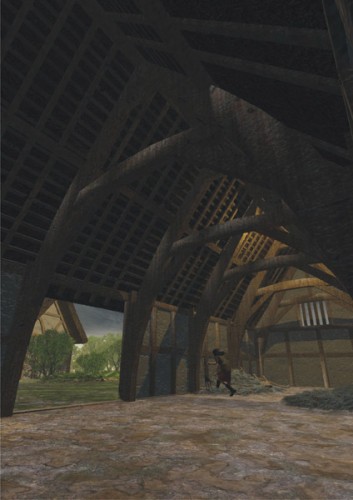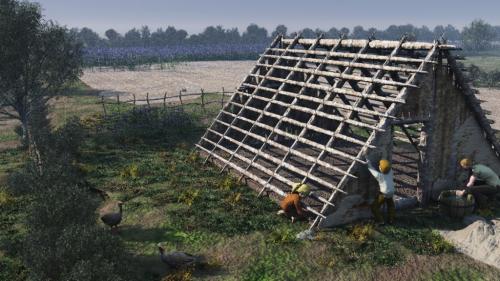- This website reflects our views on the Terminal 5 site based on many years of post-excavation analysis, which culminated in the publication of the final volume of the T5 report in 2010.
The Heathrow Landscape
How do we know this?
Find out more details in our archaeological evidence sectionHeathrow Airport
The Archaeologists
Framework Archaeology
Category Archives: The Antique Landscape
1066-1499 Medieval Manors

Interior of the medieval barn.
Manors to the south and west of London sold pigs, geese and chickens to the London market, and sometimes luxury items to richer customers. In 1293/4 and 1324 the Manor of Harmondsworth was keeping swans and peacocks.
Heathrow in the Medieval Period : c. 11th – 15th centuries
With the Norman invasion of 1066 the Saxon kingdom was conquered and a new social order imposed. The majority of agricultural land passed into the hands of the Norman elite who organised the landscape into estates and manors. The indigenous population became tenant farmers or bonded labour.
During the Terminal 5 excavations a relatively extensive medieval landscape was exposed including the remains of timber buildings, drainage ditches and boundary ditches found to contain medieval pottery. Many of the medieval ditches were recut along the same alignment as the ditches of the Bronze Age field systems. This suggests that banks and hedges of the Bronze age were still in existence over 2,500 years after they were originally created.
We are fortunate that at Heathrow we have been able to enrich our archaeological evidence with historical research.
The medieval manor of Harmondsworth was held by the Abbey of St Catherine’s at Rouen from shortly after the Norman conquest until 1391. Throughout the medieval centuries the main manor of Stanwell was held by the descendants of William fitz Other, who took the surname of Windsor because of their office of Constable of Windsor Castle. Most of the Windsor family probably lived at Stanwell in a manor house on the site of the later Stanwell Place to the west of the village. The impact of the Norman conquest on the area resulted in the inclusion of several manors in a castle-guard system attached to Windsor Castle. Stanwell manor was held from the Crown as half a knight’s fee and owed 16sh 8d to Windsor every 40 days for castle guard.
The largest holding in each manor was the lord’s demesne or home farm, consisting of arable land in the open fields, meadows in the Colne valley and pasture on Hounslow Heath and elsewhere. The villein tenants of the manors had holdings which each consisted of a series of cultivated strips in the common fields, allotted doles of meadow land and rights to pasture, in return for services performed for the lord of the manor on his demesne lands. They appear in rentals and conveyances of the 13th to 16th centuries at Harmondsworth and Stanwell holding virgates of about 30 acres, or half-virgates, or smaller landholdings around cottages. In Harmondsworth there was a great deal of sub-division and sub-letting of tenant holdings. Tenants paid a fine called a heriot to the lord when they inherited their holdings, normally consisting of their “best beast”. At Harmondsworth when the tenants had no animals, they sometimes paid in clothing, tools or furniture.
Almost all the arable land in Stanwell and Harmondsworth lay in open fields divided into cultivation strips or selions, which occupied a large percentage of both parishes. Strips of both demesne and tenant land were intermingled in the fields of both manors, grouped in numerous furlongs. In the 17th century the tenants of the open field land at Stanwell met at one of the village inns on four staking days each year to make the division of the strips. The ridge and furrow strips excavated in the T5 project lay in Longford Field in the manor of Harmondsworth. In 1404 tenants were fined in the Harmondsworth manor court for removing hedges and allowing their animals to enter the lord’s meadows and corn.
Manorial accounts show what crops were grown on the demesne land in particular years. Since the demesne arable strips were mostly intermingled in the common fields with the strips of the free and bond tenants, they must also have grown the same crops in similar proportions. Relatively little attention was paid in medieval agriculture to weeding crops, and environmental samples of plant remains from medieval sites normally contain a rich weed flora.
Between 1250 and 1350 demesnes in the Thames valley grew rye as the dominant crop, followed by barley, oats and wheat in that order of importance. Harmondsworth in 1293/4 was growing more wheat and oats than other crops, and wheat was accelerating in importance. Raising a variety of crops gave insurance against the failure of a particular crop in any one season. As barley and oats were normally sown in spring, and wheat and rye in autumn, the work of ploughing, manuring and sowing was spread more evenly over the year. This made the utilisation of tenants’ services and the rotation of crops easier. The leguminous crops of peas and vetch were cultivated extensively in England from the 13th century onwards to replace nitrates in exhausted soils, suppress weed growth and improve fodder supplies. Only a small portion of the demesne land was left fallow in each year.
Manuring fallow fields by folding sheep on them was an integral part of the open field system of agriculture, the sheep acting as mobile muckspreaders within moveable folds made from hazel hurdles. The sheep of whole villages were controlled in this operation by communal shepherds. Dung cart and dung forks formed part of Harmondsworth manor’s equipment in the 15th century; muck and rubbish from the manor courtyard was spread on the fields as part of the services owed by the tenants.
The Domesday Book survey implies that teams of oxen were used to draw ploughs in the 11th century, the demesne teams using eight oxen, the tenants ploughing with smaller teams. In the 12th and 13th centuries work horses called stots or affers replaced oxen as the main draught animals in Middlesex. Manors to the south and west of London sold pigs, geese and chickens to the London market, and sometimes luxury items to richer customers. In 1293/4 and 1324 Harmondsworth was keeping swans and peacocks.
It was necessary to move much of this stock around from common grazing to enclosed pasture fields to fallow grazing on the stubble after the harvest. Small greens and grazing areas were linked by a network of hedged lanes and wider driftways. In Stanwell the linked grazing areas of Farther Moor, Hither Moor, Spout Moor and Borough Green formed a stock movement route from the meadow lands of the Colne valley, between the open arable fields of the manor and the enclosed fields of its northern edge, to the pasture lands of Hounslow Heath. The excavations discerned patterns of ditches near Borough Green which could be interpreted as stock funnels.
410-1066 AD A New Beginning

A Saxon family work on the construction of a building. Flax fields are visible beyond.
Following Britain’s exit from the contracting Roman Empire, the towns and cities, which had already been in decline during the later part of the Roman period, rapidly fell into disuse. Severed from the wider network of the Roman Empire the focus appears to return to the local scale and immediate landscape. However, processes were at work, which led to the emergence of Saxon society. At Heathrow a dispersed, drifting pattern of settlement seems once again to emerge, set within a sparsely occupied land. Excavations south of the medieval and present day village of Longford revealed a settlement of sunken-featured buildings, pits and postholes dating to the 6-7th century AD. People continued to cultivate the land, and also seem to have grown flax to provide linen and oil. Despite the dearth of evidence from the current excavations for the Middle Saxon period, the region in general saw the emergence of more stable settlement locations at this time, with increasing nucleation in the late Saxon period leading to the familiar pattern of villages and open fields. It seems likely that the excavated Saxon settlement eventually developed into the medieval village of Longford that we see today.
The Antique Landscape
Following Britain’s exit from the contracting Roman Empire, the towns and cities, which had already been in decline during the later part of the Romano-British period, rapidly fall into disuse. Severed from the wider network of the Roman Empire the focus appears to return to the local scale and immediate landscape. However processes were at work which lead to the emergence of Saxon society.
The materials dating from periods represented in these landscapes are still under investigation. Our understanding of the these landscapes therefore remains incomplete.
This was a period when people were having to cope with a breakdown in all aspects of the complex society of the Romano British period and adapt to an influx of settlers of Northern European descent.
At Heathrow a dispersed pattern of settlement seems once again to emerge. For example just south of the present day medieval village of Longford is a settlement consisting of rectangular buildings dating to the 6th century AD. A stag broach found in a pit in the settlement may originate from the north western Mediterranean area. There is some evidence of arable cultivation in a generally open scrubby landscape. Heathland also seems to be present.
Out of this Saxon settlement developed the medieval village of Longford, elements of which remain today.
